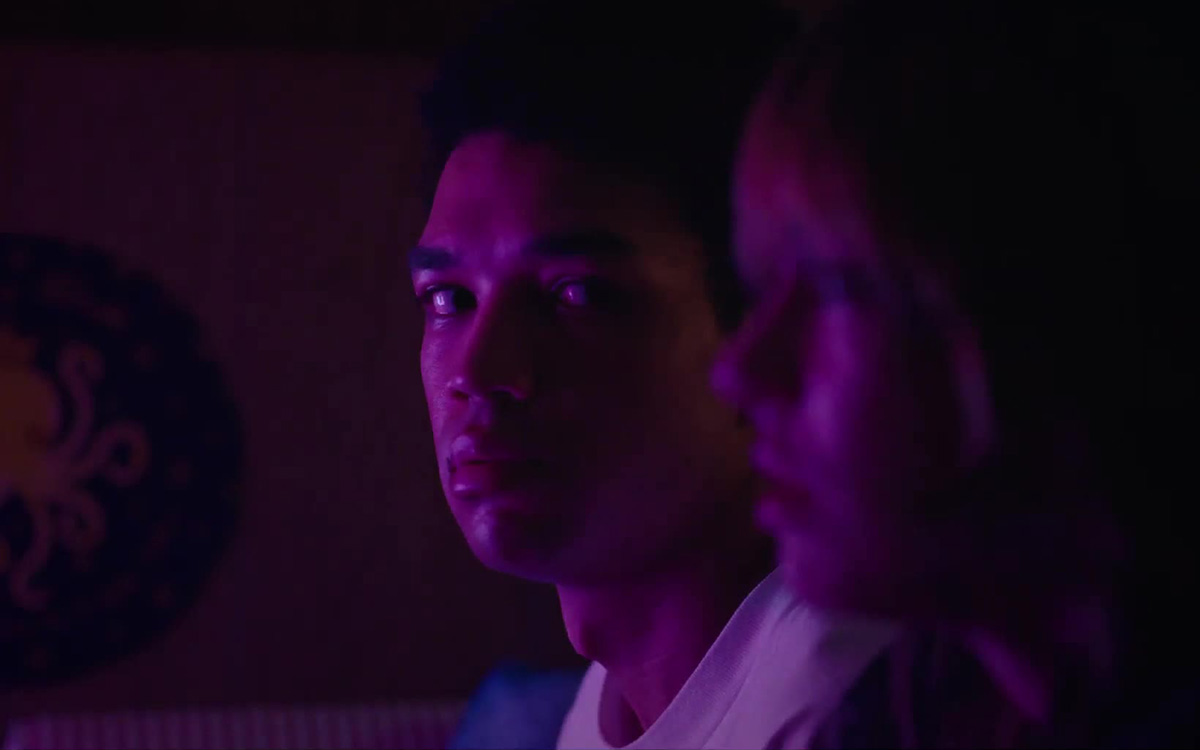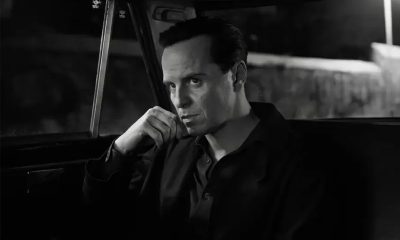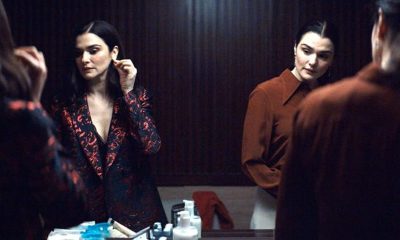Movies
Queer ‘TV Glow’ a surreal horror gem
Challenging and surprising us in a way that feels thrillingly audacious

In an age when so much of our consciousness is fixated on screens, it’s no surprise that the year’s most effectively soul-shaking horror film so far should be about precisely that.
It’s certainly not the first movie to take on the topic. Using television and computer screens to evoke creepy chills was a “thing” even before David Cronenberg used “Videodrome” to blur the lines between the physical world and the electronically conveyed imitation of it we often substitute for the “real thing.” In “I Saw the TV Glow,” however, the focus is not so much about the natural fears that arise from our reliance on technology to help us navigate our lives – the dangers of artificial intelligence or the violation of privacy to manipulate us or make us vulnerable – as it is about something much more primal. Filmmaker Jane Schoenbrun’s second feature might center on our fears around pop culture obsessions and the dangerously delusional fantasies they inspire, but its real agenda lies in a somewhat less obvious direction.
Tapping into shared millennial memories about the kid-friendly fan-culture fodder our televisions fed us in the 1990s, Shoenbrun’s movie revolves around Owen (Justice Smith), whose early teen years take place within that era. Reserved, anxious, and out-of-step with the conventional expectations embraced by his parents (Danielle Deadwyler and Limp Bizket frontman Fred Durst), seventh-grade Owen (Ian Foreman) finds himself drawn to lesbian ninth-grader Maddy (Brigette Lundy-Paine) when he spots her reading a book about a TV show called “The Pink Opaque.” His fascination, partly fueled by the “forbidden” nature of a series that airs past his strictly enforced bedtime, leads the two into a secretive friendship, in which they bond over the quirky fantasy it presents – in which two teen girls with a psychic connection battle monsters together despite living on opposite sides of the world – and come to experience it as an escape from reality, which reflects and helps to alleviate their own respective unaddressed personal traumas.
Fast forward to roughly a decade later, when Owen, now working in a go-nowhere job at the local movie multiplex, reunites with his former friend – surprisingly, considering that she had disappeared around the same time that their favorite TV obsession was canceled abruptly, with a never-to-be-resolved cliffhanger left as a final discordant note. She tells him a disturbing tale of being trapped inside “the world of the show” after memories of “The Pink Opaque” began to blend with reality in her mind, suggesting that their own identities are somehow tied to its two heroines and that its outlandish mythology is somehow more “real” than the lives they remember living themselves – and triggering a similar process in Owen after their encounter leaves him questioning his own memories of the series and its influence over his fate.
Anyone who has seen Schoenbrun’s debut feature – “We’re All Going to the World’s Fair” (2021), which, like “I Saw the TV Glow,” premiered to acclaim at the Sundance Film Festival, putting the nonbinary filmmaker in the upper bracket of rising talents to watch – will know that their unique narrative approach has a way of keeping the viewer off balance, and that’s something that works brilliantly to give the newer feature its disconcerting impact. Though it incorporates elements of the “body horror” subgenre to elicit some squirmy moments, it’s more unsettling than outright scary, achieving its creepiness by undermining our perceptions and reminding us of the unreliability of memory – in essence, by removing the illusion of certainty from our experience of reality, calling everything we assume about it into question. We aren’t the first to note the similarities between the filmmaker’s approach and that of David Lynch, whose disorienting nonlinear style would have obvious parallels to theirs even if it wasn’t peppered with visual callbacks to some of the latter director’s iconic work; far from being mere imitation, however, it’s the use of a shared visual language to take us on a surreal and sometimes nighmarish journey, which operates under the malleable rules of dream logic as it shape-shifts its way through a narrative that feels as much like free-association as it does a story.
What makes it particularly effective is that it captures the kind of cultish fandom those of latter generations feel around the precious TV memories of their youth – frequently around the kind of loopy, outlandish sci-fi fantasy shows like the one at its center – and the reasons why such pop culture fodder have such appeal for anyone who, like its two protagonists, feels like an outsider in a world that seems to have no place for them. We’ve all felt like that at some time or another, no matter which generation we are from, so we can relate – just as we can relate to the experience of revisiting a show we loved from our youth and finding it different than we remembered, something this movie deploys brilliantly to hook us into its premise and spark our own paranoid fantasies about mind control over the broadcast waves, supernatural or otherwise.
But while Shoenbrun’s film succeeds masterfully at triggering all those “hidden message” fantasies that emerge in our pop culture – the hubbub over “backward masking” on rock albums comes to mind, or the uproar over the demonic influence of role playing games like “Dungeons and Dragons” – it delivers a much more existential level of fear almost through its stylistic approach alone. By challenging not only our memories of the past but our perception of the here-and-now, “I Saw the TV Glow” pulls the rug out from under our belief in a concrete reality. Further, by following its saga through several stages of life – it follows Owen over a course of 30 years – it drives home the inevitable connection between aging, loss of control over our own minds, and ultimately, death itself as the fate which awaits us all.
Yes, that sounds pretty grim, and melancholy to boot – but after all, why shouldn’t a horror film embrace those qualities? And like the best horror films, this one finds a transcendent beauty in the twisted darkness it shows us, even if it offers us little – beyond the escapist fantasies we cling to from our youth, that is – to comfort us as we face the grim uncertainties of our own lives.
How it accomplishes that is something we’ll leave you to discover for yourself, but we would be remiss not to note the movie’s deeply queer/trans subtext – both its lead characters are ostracized for non-conformity in their sexual or gender orientations, though most of that is conveyed “between the lines” rather than explicitly explored – which brings a tangible and resonant layer of metaphor to the proceedings.
Admittedly, “TV Glow” might not be the kind of horror film for all fans of the genre – its nonlinear style and surrealistic resistance to concrete interpretation are sure to alienate those looking for a more easily-digestible experience. Nevertheless, it’s a rare genre film that steps outside its expected boundaries to challenge and surprise us in a way that feels thrillingly audacious – and that’s more than enough for us to jump on board.
Movies
Gender expression is fluid in captivating ‘Paul & Trisha’ doc
Exploring what’s possible when you allow yourself to become who you truly are

Given the polarizing controversies surrounding the subject of gender in today’s world, it might feel as if challenges to the conventional “norms” around the way we understand it were a product of the modern age. They’re not, of course; artists have been exploring the boundaries of gender – both its presentation and its perception – since long before the language we use to discuss the topic today was ever developed. After all, gender is a universal experience, and isn’t art, ultimately, meant to be about the sharing of universal experiences in a way that bypasses, or at least overcomes, the limitations of language?
We know, we know; debate about the “purpose” of art is almost as fraught with controversy as the one about gender identity, but it’s still undeniable that art has always been the place to find ideas that contradict or question conventional ways of viewing the world. Thanks to the heavy expectation of conformity to society’s comfortable “norms” in our relationship with gender, it’s inevitable that artists might chafe at such restrictive assumptions enough to challenge them – and few have committed quite so completely to doing so as Paul Whitehead, the focus of “Paul & Trisha: The Art of Fluidity,” a new documentary from filmmaker Fia Perera which enjoyed a successful run on the festival circuit and is now available for pre-order on iTunes and Apple TV ahead of a VOD/streaming release on July 9.
Whitehead, who first gained attention and found success in London’s fertile art-and-fashion scene of the mid 1960s, might not be a household name, but he has worked closely with many people who are. A job as an in-house illustrator at a record company led to his hiring as the first art director for the UK Magazine Time Out, which opened the door for even more prominent commissions for album art – including a series of iconic covers for Genesis, Van der Graaf, Generator, and Peter Hammill, which helped to shape the visual aesthetic of the Progressive Rock movement with his bold, surrealistic pop aesthetic, and worked as an art director for John Lennon for a time. Moving to Los Angeles in 1973, his continuing work in the music industry expanded to encompass a wide variety of commercial art and landed him in the Guinness Book of World Records as painter of the largest indoor mural in the world inside the now-demolished Vegas World Casino in Las Vegas. As a founder of the Eyes and Ears Foundation, he conceived and organized the “Artboard Festival”, which turned a stretch of L.A. roadway into a “drive-through art gallery” with donated billboards painted by participating artists.
Perera’s film catches up with Whitehead in the relatively low-profile city of Ventura, Calif., where the globally renowned visual artist now operates from a combination studio and gallery in a strip mall storefront. Still prolific and producing striking artworks (many of them influenced and inspired by his self-described “closet Hinduism”), the film reveals a man who, far from coming off as elderly, seems ageless; possessed of a rare mix of spiritual insight and worldly wisdom, he is left by the filmmaker to tell his own story by himself, and he embraces the task with the effortless verve of a seasoned raconteur. For roughly the first half of the film, we are treated to the chronicle of his early career provided straight from the source, without “talking head” commentaries or interview footage culled from entertainment news archives, and laced with anecdotes and observations that reveal a clear-headedness, along with a remarkable sense of self-knowledge and an inspiring freedom of thought, that makes his observations feel like deep wisdom. He’s a fascinating host, taking us on a tour of the life he has lived so far, and it’s like spending time with the most interesting guy at the party.
It’s when “Art of Fluidity” introduces its second subject, however, that things really begin to get interesting, because as Whitehead was pushing boundaries as an in-demand artist, he was also pushing boundaries in other parts of his life. Experimenting with his gender identity through cross-dressing since the 1960s, what began tentatively as an “in the bedroom” fetish became a long-term process of self-discovery that resulted in the emergence of “converged artist” Trisha Van Cleef, a feminine manifestation of Whitehead’s persona who has been creating art of her own since 2004. Neither dissociated “alter ego” nor performative character, Trisha might be a conceptual construct, in some ways, but she’s also a very authentic expression of personal gender perception who exists just as definitively as Paul Whitehead. They are, like the seeming opposites of yin and yang, two sides of the same fundamental and united nature.
Naturally, the bold process of redefining one’s personal relationship with gender is not an easy one, and part of what makes Trisha so compelling is the challenge she represents to Paul – and, by extension, the audience – by co-existing with him in his own life. She pushes him to step beyond his fears – such as his concerns about the hostile attitude of the shopkeeper next door and the danger of bullying, brutality, and worse when Trisha goes out in public – and embrace both sides of his nature instead of trying to force himself to be one or the other alone. And while the film doesn’t shy away from addressing the brutal reality about the risk of violence against non-gender-conforming people in our culture, it also highlights what is possible when you choose to allow yourself to become who you truly are.
As a sort of disclaimer, it must be acknowledged that some viewers may take issue with some of Whitehead’s personal beliefs about gender identity, which might not quite mesh with prevailing ideas and could be perceived as “problematic” within certain perspectives. Similarly, the depth of his engagement with Hindu cosmology might be off-putting to audiences geared toward skepticism around any spiritually inspired outlook on the world. However, it’s clear within the larger context of the documentary that both Paul and Trisha speak only for themselves, expressing a personal truth that does not nullify or deny the personal truth of anyone else. Further, one of the facets that gives “Art of Fluidity” its mesmerizing, upbeat charm is the sense that we are watching an ongoing evolution, a work in progress in which an artist is still discovering the way forward. There’s no insinuation that any aspect of Paul or Trisha’s shared life is definitive, rather we come to see them as a united pair, in constant flux, moving through the world together, as one, and becoming more like themselves every step of the way.
That’s something toward which we all would be wise to aspire; the acceptance of all of our parts and the understanding that we are always in the process of becoming something else would certainly go a long way toward making a happier, friendlier world.
Movies
New Cyndi Lauper doc brings overdue spotlight to queer ally
‘Let the Canary Sing’ captures a unique, era-defining star

Every era in our cultural memory has given rise to popular artists that helped to define them, but few can be said to have made as definitive an impact as Cyndi Lauper in the early ‘80s. Splashing onto our airwaves and across our television screens (courtesy of the newly minted MTV) with a defiantly upbeat and colorful blast of society-shifting energy, her proclamation that “Girls Just Want to Have Fun” caught the world off guard with a feminist anthem disguised as a good-time party song, and her sense of quirky punk style became an iconic influence over the “look” of an entire decade. In some ways, you could almost say Cyndi Lauper was the ‘80s.
For many people who grew up or came of age during her rise from unknown girl singer to pop music phenomenon, that might be the extent of their knowledge of her life and career. Despite the success (and Grammy Award) she achieved with her first few hits, the ever-roving eye of public attention inevitably moved on to the next new superstar, and her later efforts – while not exactly ignored – never managed to garner as much attention.
That doesn’t mean she has been inactive, though, as her die-hard fans (and there are many) well know; this is especially true in the queer community, where she has long been recognized and celebrated as a staunch ally – which is why it seems apt that Pride month should coincide with the release of “Let the Canary Sing,” a new documentary profile of Lauper that premieres on Paramount Plus this week.
Directed by Emmy-winning documentarian Alison Ellwood, “Canary” takes its name from a comment made by the judge in a legal case that opened the door for Lauper’s stardom – no spoilers here, you’ll have to watch the movie to find out more. It undertakes the telling of a well-rounded and comprehensive life story to cast that stardom in a new light. Maintaining a comfortable sense of chronology, it begins with Lauper’s childhood, growing up in Brooklyn (and later, Queens) in a close-knit family as the middle child of three with a divorced single mother, and follows the trajectory of her life – rebellious, risk-taking teen to driven, passionate artist and activist – through her love of music, her rise to fame, her struggle to evolve in an industry that rewards predictable familiarity, her emergence as an LGBTQ advocate, and her expansion into a genre-leaping artist whose reach has extended beyond pop culture to earn her renown for her versatility. It also covers her accomplishment as the first woman to win a Tony Award as sole composer of the music and lyrics of “Kinky Boots,” the Harvey Fierstein-scripted drag-themed Broadway musical which made a star of Billy Porter – and nabbed her another Grammy (for its Original Cast Recording), to boot. Bolstered by extensive current interview footage with Lauper herself, as well as elder sister Elen, younger brother Fred, and other important figures from her personal and professional life, it finds an arc that reveals its subject as an authentic and uncompromising visionary dedicated to “lifting up” the entire human race.
That would sound hyperbolic – and probably more than a little disingenuous – if Lauper did not come across so palpably on camera. Whether it’s footage from a decades-old Letterman show or newly filmed commentary shot specifically for the film, her “true colors” come shining through (forgive us for that one, we couldn’t resist) to provide ample evidence that, even if she didn’t always know where she was going, she always knew it would be the direction of her own choosing. Indeed, as the movie makes clear, much of the reason behind Lauper’s fade from the pop spotlight was the result of her refusal to repeat herself, to compromise her own path by delivering pale copies of the formula that had made her an “overnight success” after 15 years of trying. Although the documentary doesn’t insinuate this, it’s impossible for us not to suspect that homophobic backlash following her public embrace and advocacy of the queer community – something surely intertwined with her close bond to sister Elen, an out lesbian who is positioned in Ellwood’s film as a key pillar of both emotional and artistic support in Lauper’s life – may have had something to do with the mainstream music industry’s ambivalence toward her as she pursued her artistic impulses beyond the flashy appeal of her debut album.
In any case, “She’s So Unusual,” as a debut album title, proved to be an ironic foreshadowing of the very reasons she was unable to “stay in her own lane” well enough to remain in the good graces of a public (or, perhaps more truthfully, of record executives) that only wanted more of the same. Lauper has never been one to conform, and it’s made her vulnerable, like so many other unrelenting female voices both before and after her, to the mainstream insistence on reinforcement of the comfortable over the breaking down of boundaries.
“Let the Canary Sing” captures all of this succinctly, yet with layered and sophisticated nuance, as it pays its tribute to a pop icon whose seminal work has continued to resonate after more than 40 years. Unavoidably, perhaps, it sometimes feels like a “Behind the Music” episode or a “puff piece” for an artist about to launch a new project – indeed, Lauper announced a “farewell tour” of 23 cities, as well as a “companion piece” greatest hits album release, on the eve of the movie’s streaming debut – but it pushes past such irrelevant comparisons thanks to the palpable sincerity conveyed onscreen, not only from her, but from all the people in her orbit whose comments about her are included in the film.
Of course, it must be said that anyone who’s not a “Cyndi Lauper fan”, whether by virtue of generational gaps or personal tastes, will probably not be drawn to watch a filmic love letter to her, and that’s a shame. It (and she) has the power to make viewers into true believers not only in her talent, but in her message of acceptance, inclusion, and unconditional love. Part of that, hinges on Ellwood’s skill as a filmmaker and teller of real-life stories, but the lasting impact rests on the persona of the star herself, who exudes a genuine air of transcendence and makes us not only feel instantly comfortable, but completely “seen” and validated, no matter who we are or which spectrum we might be on.
It’s hard to fake the kind of sincerity that makes that possible, and nothing about “Canary” suggests that Cyndi Lauper has any interest in being fake, anyway.
Movies
Lesbian, bi, trans stories dominate queer crop of summer movies
Comic book adaption, horror thrillers, and more on the way

Summer is almost upon us, and that means it’s time to look ahead toward another season of movies – but for queer movie fans, the typical “popular” summer escapist fare might not have quite the right appeal. Not to worry: the Blade is here to offer up our usual list of titles to watch for.
Backspot (May 31, in theaters) Helmed by nonbinary Toronto filmmaker D.W. Waterson in their feature directorial debut, this Elliot Page-produced sports drama has been described as “Whiplash” for competitive cheerleaders. Focusing on ambitious cheerleader Riley (Devery Jacobs of “Reservation Dogs”), it’s a heavily queer-themed coming-of-age tale that weaves romance with hard-hitting “behind-the-scenes” as she and her girlfriend, selected for an all-star squad, square off against a hard-edged head coach (out queer “Westworld” star Evan Rachel Wood) who demands a drive toward perfection – forcing Riley to confront her own crippling anxiety to keep her dreams from crumbling into dust. Also starring Shannyn Sossamon (“A Knight’s Tale”), Kudakwashe Rutendo, Thomas Antony Olajide, and Wendy Crewson
Let the Canary Sing (June 4, Paramount Plus) Billed as “the story of music’s most authentic superstar,” this career-spanning profile of queer-adjacent pop icon Cyndi Lauper from award-winning documentarian Alison Ellwood delivers a chronicle of her ascent to stardom and an exploration of her impact and the legacy that she has bestowed through her beloved music, iconic style, unapologetic feminism and fearless advocacy. There’s not much we can say about this one except that it’s a perfect treat for fans – and an enticing invitation for future fans – to get a close-up look at a legend who has truly earned her status.
Queendom (June 14, in theaters/on demand) Filmmaker Agniia Galdanova is behind this award-winning SXSW documentary, which follows queer Russian performance artist Jenna Marvin as she takes to the streets of Moscow to stage theatrical protests against the country’s Putin-led authoritarian regime – all while working behind the scenes to escape her homeland and flee to a place where her queer identity isn’t a crime. Coming in the middle of Pride month, it’s a potent reminder that – in many parts of the world – queer people still live in fear of homophobic suppression, but it’s also an inspiring story about the risky business of speaking truth to power.
Summer Solstice (June 14, in theaters) It should go without saying that telling trans stories is important right now, and this film from Brooklyn-based director Noah Schamus is exactly the kind we need. Following trans man Leo (Bobbi Salvör Menuez) as he hustles his way through a life of auditions, acting classes, barista jobs, and “situationships,” it segues into a thoughtful exploration of interpersonal gender politics when an old friend – cisgender and straight Eleanor (Marianne Rendón), takes her on an impromptu weekend getaway in upstate New York. Dealing with the new dynamics (and old emotions) of relationships after transition, it’s a movie which goes a long way toward revealing both the commonalities and the unique complications that ultimately make any trans story, told authentically, into a human story.
Cora Bora (June 15) If you’re a fan of Max’s queer-friendly queer-favorite series “Hacks,” you’ll need no introduction to the comedic personality at the center of this “dramedy” from director Hannah Pearl Utt. Out bisexual comedian and actress Megan Stalter stars as a “failed girl musician” who sets out not just to revitalize her career prospects but to win back the affections of her ex-girlfriend – and forges a new life path for herself in the process. Stalter, known mostly for her endearingly painful, over-the-top comedic portrayals of deluded-but-inextinguishable confidence, gets an opportunity to show a much wider range of layers here than she’s been allowed to explore before – but don’t worry: she’s still hilarious! Jojo T. Gibbs, Manny Jacinto, Ayden Mayeri, Thomas Mann, Chelsea Peretti, and queer comedy icon Margaret Cho also star.
Fancy Dance (June 21, in theaters/AppleTV) This debut feature from filmmaker Erica Tremblay is also the eagerly awaited return to the big screen of Indigenous American actor Lily Gladstone, whose Oscar-nominated turn in last year’s “Killers of the Flower Moon” not only made history but made them into a star. Here, they play a queer hustler who becomes the guardian of her niece (Isabel DeRoy-Olson) when her sister disappears. Trying to stay one step ahead of a deadbeat dad (Shea Wigham, “White Lotus”) and an American justice system that is weighted against the rights of Indigenous women, they hit the road into the backcountry of their Oklahoma reservation on a quest to find the missing mother. The “buzz” is already predicting another Oscar nod for Gladstone, but whether or not that’s just Hollywood hyperbole, it’s sure to be one of the summer’s must-see picks.
Sing Sing (July 12, limited theaters/August 2, wide release) Speaking of last year’s Oscar nominees, powerhouse out-gay-thespian-of-color Colman Domingo is the lynchpin of this based-on-a-true-story prison drama about a wrongly convicted inmate at the notorious correctional facility who finds solace in a rehabilitation theater program, mounting productions with fellow prisoners and rising above the crushing isolation of incarcerated life. Intense and topical, yet also inspirational and uplifting, it debuted at last year’s Toronto International Film Festival alongside Domingo’s other starring vehicle, “Rustin” – and his performance in it was praised as superior, Oscar nod notwithstanding. Consider that alone a recommendation to add this Greg Kwedar-directed real-life tale to your watchlist.
Deadpool & Wolverine (July 26, in theaters) It’s rare for us to include a big-ticket comic book film in our list of upcoming queer titles, but we can’t ignore the appeal of this new Marvel entry in which the two title characters are thrown together for a mission that will rewrite the history of the “MCU” forever. Sure, it sounds like a convenient way to hit the “reset” button and take the blockbuster franchise in a new direction – but it’s also the irresistible culmination of a longstanding “man-crush” held by the “canonically pansexual” Deadpool (Ryan Reynolds) for X-Man MVP Wolverine (Hugh Jackman), fueled enthusiastically by both stars since long before this clever concept vehicle ever got greenlit. Directed by Shawn Levy, and also starring nonbinary actor Emma Corrin in their first “villainous” role, it features Morena Baccarin, Rob Delaney, Leslie Uggams, Karan Soni, and Matthew Macfadyen, too – and while it may not be highbrow cinema, based on the irreverent, borderline absurdist tone of both the “Deadpool” comics and the previous film installments made from them, it’s likely to be a lot of fun.
Cuckoo (Aug. 9, in theaters) Last but not least, this German-American co-production – a “Shining”-esque horror tale about a family vacationing in the Alps that find themselves endangered after discovering the resort town in which they are staying harbors a web of disturbing secrets – will undoubtedly draw the attention of hardcore horror fans. But it also has strong, built-in queer appeal in the form of its transgender star, Hunter Schafer (“Euphoria”), who takes on her first starring film role as the movie’s “final girl.” Dan Stevens, Jessica Henwick, Jan Bluthardt, and Martin Csokas also star, with direction and screenplay both coming from Tilman Singer.
-

 District of Columbia5 days ago
District of Columbia5 days agoD.C.’s beloved Duplex Diner closes its doors
-

 Politics5 days ago
Politics5 days agoEXCLUSIVE: Biden-Harris campaign debuts ads targeting LGBTQ voters
-

 District of Columbia5 days ago
District of Columbia5 days agoPride weekend brings parade, festival, fireworks amid perfect weather
-

 District of Columbia3 days ago
District of Columbia3 days agoD.C. police chief, officers marched in Pride parade in uniform












